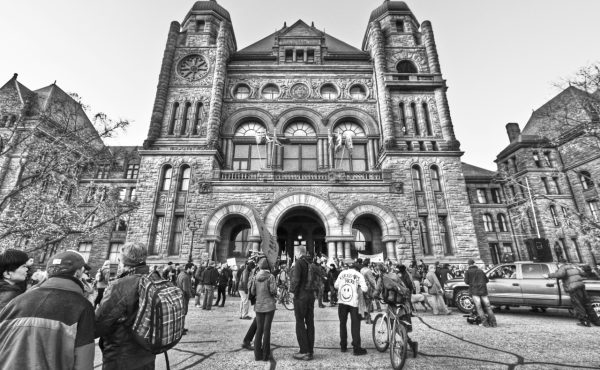
Is Shelley Carroll merely pouting about not getting her fair share of the OneCity limelight, or does she have a legitimate critique of the much-lauded transit strategy that Karen Stintz and Glen de Baeremaeker launched last month?
Warning: this column is not going to be about mayoral speculation.
If we scroll back to the March special council meeting, and the decisions made therein, a couple of points jump off the page:
During that fascinating, nail-biting session, Scarborough’s Raymond Cho – who, this weekend, came out rather loudly in favour of the OneCity plan to top-up the Scarborough LRT funds to extend the Bloor-Danforth line to Scarborough Town Centre and on to points north of the 401 – moved a widely supported motion asking the province and the feds to consider extending the SRT conversion out to Malvern Town Centre and on to the University of Toronto’s Scarborough campus. That’s what this group of politicians said they wanted to do, less than four months ago.
Cho, during the same session, also won broad support for another motion asking city staff to report back in early October of this year about the feasibility of establishing a “Toronto Transit Infrastructure Reserve Fund.”
According to Carroll, senior city officials are now grinding out the analysis that will look at the feasibility of the revenue tool cited by the One City group – the so-called “CVA uplift,” which would allow the city to continuously capture some of the increased real estate values reflected in the coming re-assessment by a provincial agency. The move would require a change in provincial legislation.
Carroll argues that council should hang tight until the fall and see what city staff come back with — in terms of the viability of such a revenue source and how much cash it would yield — instead of trying to press ahead with an approval timetable that begins with a request at this council week for a detailed review of the OneCity proposal. “For me, there’s only ever been a timing issue,” she insists.
While Carroll says she’s concerned about raising and then dashing voters’ hopes for transit expansion (a non-trivial detail), the nut of her objection with Stintz’s accelerated timetable has more to do with the need to maintain collaborative relationships between Toronto council and the 905 municipalities as we all trudge towards the big bang moment next year when Metrolinx unveils the long-awaited investment strategy for funding the $50 billion-plus Big Move.
Inside GTA municipal circles, there’s growing backroom discussion about how all these cities should respond to the various funding tools that Metrolinx will recommend to its political masters at Queen’s Park.
Everyone knows the list — highway tolls, sales taxes, vehicle registration fees, parking levies, transit fare increases, etc. — but no one yet understands the political and financial geography of this new proposed tax burden. There’s absolutely no doubt that a key piece of the advice to the minister will involve a detailed analysis of who can expect to pay what (e.g., how much will it cost a Mississauga family relative to a downtown Toronto couple, etc.), and how to ensure that the load is spread relatively equitably. Those decisions, of course, will require the wisdom of Solomon and the courage of a test pilot. The Liberals, bless their souls, have revealed nothing whatever about how they intend to carve the turkey. I don’t think they have a clue.
So back to Carroll: in her read, it makes more sense for Toronto council to work out broad points of consensus with the 905ers instead of bursting out of the gate first. The best venues for such deliberations, she says: the August confab of the Association of Municipalities of Ontario and its large urban mayors caucus. “What’s coming soon is a very formal discussion and Toronto needs to be at that table.”
Now, it must be said that because David Miller’s administration negotiated a separate peace with Dalton McGuinty’s Liberals when he got the City of Toronto Act approved, the City no longer participates in either the AMO or the urban mayors caucus. But as Carroll notes, the City should, and that’s more or less what Josh Matlow’s motion at council this week requests.
She told me Stintz would be well positioned to represent Toronto council’s interests to other 905 municipal leaders, but she first needs to assess the political downside — in terms of negotiating with the province — of moving unilaterally.
I’d say there’s merit to what Carroll is saying, and the reason has to do with the infuriatingly cagey way in which Queen’s Park is backing into the formal portion of the debate about the investment strategy, once it is released. I’m not expecting the Liberals to take the populist route — e.g., a Los Angeles-style referendum — nor do I see them coming forward with a buffet-style approach (i.e., the municipalities can somehow choose which “tools” they’d like to impose on their residents).
If, rather, you look for the political space between those two extremes, it seems clear that some kind of consensus among the large municipalities must be brokered as a proxy for public assent (cue Tim Hudak). I used the passive construction in that previous sentence, because it’s not at all evident (to me, anyway) who will do the brokering, in what forum, and according to whose timelines. All that is clear is that the province will be out shopping for deals, and those deals better include Toronto residents who, lest we forget, account for about 90% of all transit trips made in the GTA.
Stintz, like all transit advocates, can’t be blamed for running low on patience. After two years at the helm of the TTC, she knows that the province’s leisurely approach risks significant long-term inconvenience for transit users. Finally, Stintz deserves huge praise for creating space for a long-overdue debate about how to create a dedicated, local funding stream for transit that doesn’t depend entirely on the munificence of other governments. Still, Carroll makes an important point: in this tale of mystery and intrigue, the politics is now about two area codes, not one.
photo from Metro Transportation Library and Archive





3 comments
Come on John.
Stintz didn’t “create the debate”. I certainly wouldn’t call a $30 billion dollar project that involves asking for $10 billion from the Feds and $10 billion from the Province (who just gave us $8 billion) as “a plan”. And when she states a property tax increase is part of the plan, but quickly pulls it when it looks like the plan will die…well that’s not very courageous now is it?
Where is your praise for Norm Kelly’s 0.5% sales tax idea presented at the end of the Sheppard debate? It doesn’t discriminate against drivers, it taxes the 905’ers who come in on the Trains and cars and buy lunch and dinner at their offices 5 days a week and is a very reasonable level of taxation (5 Cents into a dedicated transit fund for every $10 dollars spent IS reasonable).
Lets not act like Stintz the hypocrite reinvented the wheel. From supporting Subways – to supporting Transit City – to putting all pet projects of the past 30 years on a map and calling it her “plan”. If she’s not a hypocrite then she certainly has Attention Deficit Disorder.
Or how about DeBaermaker who said during the lead up to the council Sheppard vote at a public debate (and I quote) “I would vote for the Sheppard subway tomorrow if there was funding.” So no funding for Sheppard was found but now 5 months later $30 billion is available and do-able to criss cross the city by borrowing $20 billion? And people said Ford’s math was bad????
There is an obligation to the people of this city to be intellectually honest and these two are NOT the ones to lead us forward!
Pathetic!
Well said JW. While I don’t agree with regressive taxation like sales taxes, it still is more fair and more broad-based than a special tax solely borne by property owners.
It should be noted that the idea of regional sales tax was first proposed by Lorinc here on this blog, written about numerous times (including using LA as an example), and used in a poll that Environics did for Spacing.